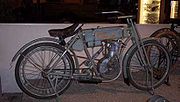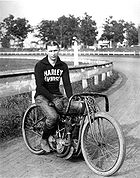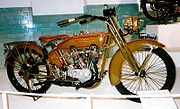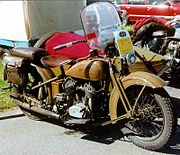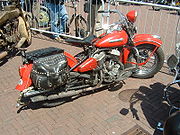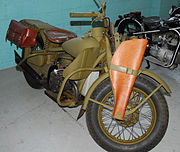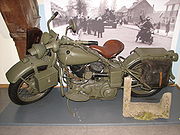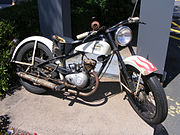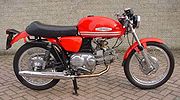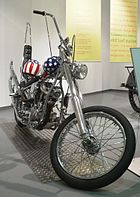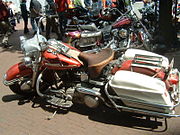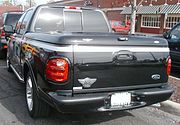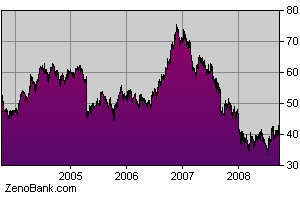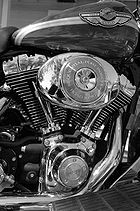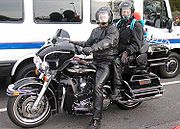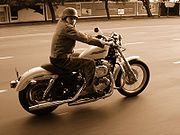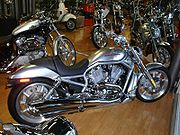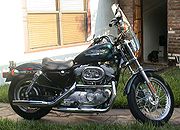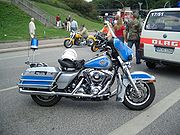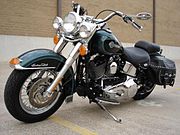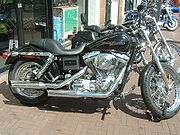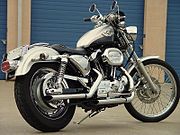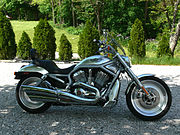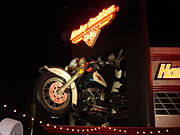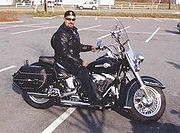
Harley-Davidson
About this schools Wikipedia selection
This Schools selection was originally chosen by SOS Children for schools in the developing world without internet access. It is available as a intranet download. Click here for more information on SOS Children.
 |
|
| Type | Public ( NYSE: HOG) |
|---|---|
| Founded | 1903 |
| Founder(s) | William S. Harley Arthur Davidson Walter Davidson William A. Davidson |
| Headquarters | Milwaukee, Wisconsin, United States |
| Key people | Keith E. Wandell, CEO |
| Products | Motorcycles |
| Revenue | |
| Operating income | |
| Employees | 9,700 (2006) |
| Subsidiaries | MV Agusta |
| Website | www.harley-davidson.com |
Harley-Davidson ( NYSE: HOG, formerly HDI), often abbreviated H-D or Harley, is an American motorcycle manufacturer. Founded in Milwaukee, Wisconsin, during the first decade of the 20th century, it was one of two major American motorcycle manufacturers to survive the Great Depression. Harley-Davidson also survived a period of poor quality control and competition from Japanese manufacturers.
The company sells heavyweight (over 750 cc) motorcycles designed for cruising on the highway. Harley-Davidson motorcycles (popularly known as "Harleys") have a distinctive design and exhaust note. They are especially noted for the tradition of heavy customization that gave rise to the chopper-style of motorcycle. Except for the modern VRSC model family, current Harley-Davidson motorcycles reflect the styles of classic Harley designs. Harley-Davidson's attempts to establish itself in the light motorcycle market have met with limited success and have largely been abandoned since the 1978 sale of its Italian Aermacchi subsidiary.
Harley-Davidson sustains a loyal brand community which keeps active through clubs, events, and a museum. Licensing of the Harley-Davidson logo accounts for almost 5% of the company's net revenue.
History
Beginning
In 1901, William S. Harley, age 21, drew up plans for a small engine with a displacement of 7.07 cubic inches (116 cc) and four-inch (102 mm) flywheels. The engine was designed for use in a regular pedal-bicycle frame. Over the next two years Harley and his childhood friend Arthur Davidson labored on their motor-bicycle using the northside Milwaukee machine shop at the home of their friend, Henry Melk. It was finished in 1903 with the help of Arthur's brother, Walter Davidson. Upon completion the boys found their power-cycle unable to conquer Milwaukee's modest hills without pedal assistance. Will Harley and the Davidsons quickly wrote off their first motor-bicycle as a valuable learning experiment.
Work immediately began on a new and improved second-generation machine. This first "real" Harley-Davidson motorcycle had a bigger engine of 24.74 cubic inches (405 cc) with 9.75 inches (25 cm) flywheels weighing 28 lb (13 kg). The machine's advanced loop-frame pattern was similar to the 1903 Milwaukee Merkel motorcycle (designed by Joseph Merkel, later of Flying Merkel fame). The bigger engine and loop-frame design took it out of the motorized-bicycle category and would help define what a modern motorcycle should contain in the years to come. The boys also received help with their bigger engine from outboard motor pioneer Ole Evinrude, who was then building gas engines of his own design for automotive use on Milwaukee's Lake Street.
The prototype of the new loop-frame Harley-Davidson was assembled in a 10 ft × 15 ft (3.0 m × 4.6 m) shed in the Davidson family backyard. Most of the major parts, however, were made elsewhere, including some probably fabricated at the West Milwaukee railshops where oldest brother William A. Davidson was then toolroom foreman. This prototype machine was functional by September 8, 1904, when it competed in a Milwaukee motorcycle race held at State Fair Park. It was ridden by Edward Hildebrand and placed fourth. This is the first documented appearance of a Harley-Davidson motorcycle in the historical record.
In January 1905, small advertisements were placed in the "Automobile and Cycle Trade Journal" that offered bare Harley-Davidson engines to the do-it-yourself trade. By April, complete motorcycles were in production on a very limited basis. That year the first Harley-Davidson dealer, Carl H. Lang of Chicago, sold three bikes from the dozen or so built in the Davidson backyard shed. (Some years later the original shed was taken to the Juneau Avenue factory where it would stand for many decades as a tribute to the Motor Company's humble origins. Unfortunately, the first shed was accidentally destroyed by contractors in the early 1970s during a clean-up of the factory yard.)
In 1906, Harley and the Davidson brothers built their first factory on Chestnut Street (later Juneau Avenue). This location remains Harley-Davidson's corporate headquarters today. The first Juneau Avenue plant was a 40 ft × 60 ft (12 m × 18 m) single-story wooden structure. The company produced about 50 motorcycles that year.
In 1907, William S. Harley graduated from the University of Wisconsin–Madison with a degree in mechanical engineering. That year additional factory expansion came with a second floor and later with facings and additions of Milwaukee pale yellow ("cream") brick. With the new facilities production increased to 150 motorcycles in 1907. The company was officially incorporated that September. They also began selling their motorcycles to police departments around this time, a market that has been important to them ever since.
Production in 1905 and 1906 were all single-cylinder models with 26.84 cubic inches (439.8 cc) engines. In February 1907 a prototype model with a 45-degree V-Twin engine was displayed at the Chicago Automobile Show. Although shown and advertised, very few V-Twin models were built between 1907 and 1910. These first V-Twins displaced 53.68 cubic inches (879.7 cc) and produced about 7 horsepower (5.2 kilowatts). This gave about double the power of the first singles. Top speed was about 60 mph (97 km/h). Production jumped from 450 motorcycles in 1908 to 1,149 machines in 1909.
By 1911, some 150 makes of motorcycles had already been built in the United States – although just a handful would survive the 1910s.
In 1911, an improved V-Twin model was introduced. The new engine had mechanically operated intake valves, as opposed to the "automatic" intake valves used on earlier V-Twins that opened by engine vacuum. With a displacement of 49.48 cubic inches (810.8 cc), the 1911 V-Twin was smaller than earlier twins, but gave better performance. After 1913 the majority of bikes produced by Harley-Davidson would be V-Twin models.
By 1913, the yellow brick factory had been demolished and on the site a new 5-story structure of reinforced concrete and red brick had been built. Begun in 1910, the red brick factory with its many additions would take up two blocks along Juneau Avenue and around the corner on 38th Street. Despite the competition, Harley-Davidson was already pulling ahead of Indian and would dominate motorcycle racing after 1914. Production that year swelled to 16,284 machines.
World War I
In 1917, the United States entered World War I and the military demanded motorcycles for the war effort. Harleys had already been used by the military in the Pancho Villa Expedition but World War I was the first time the motorcycle had been adopted for combat service. Harley-Davidson provided about 15,000 machines to the military forces during World War I.
1920s
By 1920, Harley-Davidson was the largest motorcycle manufacturer in the world. Their motorcycles were sold by dealers in 67 countries. Production was 28,189 machines.
In 1921, a Harley-Davidson, ridden by Otto Walker, was the first motorcycle ever to win a race at an average speed of over 100 mph (160 km/h).
During the 1920s, several improvements were put in place, such as a new 74 cubic inch (1200cc) V-Twin, introduced in 1922, and the "Teardrop" gas tank in 1925. A front brake was added in 1928.
In the late summer of 1929, Harley-Davidson introduced its 45 cubic inch flathead V-Twin to compete with the Indian 101 Scout and the Excelsior Super X. This was the "D" model, produced from 1929 to 1931. Riders of Indian motorcycles derisively referred to this model as the "three cylinder Harley" because the generator was upright and parallel to the front cylinder. The 2.745 in (69.7 mm) bore and 3.8125 in (96.8 mm) stroke would continue in most versions of the 750 engine; exceptions include the XA and the XR750.
The Great Depression
The Great Depression began a few months after the introduction of their 45 cubic inch model. Harley-Davidson's sales plummeted from 21,000 in 1929 to 3,703 in 1933. Despite those dismal numbers, Harley-Davidson proudly unveiled its lineup for 1934, which included a Flathead with art deco styling.
In order to survive the remainder of the Depression, the company manufactured industrial powerplants based on their motorcycle engines. They also designed and built a three-wheeled delivery vehicle called the Servi-Car, which remained in production until 1973.
In the mid-'30s, Alfred Rich Child opened a production line in Japan with the 74ci VL. The Japanese license-holder severed its business relations with Harley-Davidson in 1936 and continued manufacturing the VL under the Rikuo name.
An 80 cubic inch flathead engine was added to the line in 1935, by which time the single-cylinder motorcycles had been discontinued.
In 1936, the 61E and 61EL models with the "Knucklehead" OHV engines was introduced. Valvetrain problems in early Knucklehead engines required a redesign halfway through its first year of production and retrofitting of the new valvetrain on earlier engines.
By 1937, all Harley-Davidson's flathead engines were equipped with dry-sump oil recirculation systems similar to the one introduced in the "Knucklehead" OHV engine. The revised 74 cubic inch V and VL models were renamed U and UL, the 80 cubic inch VH and VLH to be renamed UH and ULH, and the 45 cubic inch R to be renamed W.
In 1941, the 74 cubic inch "Knucklehead" was introduced as the F and the FL. The 80 cubic inch flathead UH and ULH models were discontinued after 1941, while the 74" U & UL flathead models were produced up to 1948.
World War II
One of only two American cycle manufacturers to survive the Great Depression, Harley-Davidson again produced large numbers of motorcycles for the US Army in World War II and resumed civilian production afterwards, producing a range of large V-twin motorcycles that were successful both on racetracks and for private buyers.
Harley-Davidson, on the eve of World War II, was already supplying the Army with a military-specific version of its 45" WL line, called the WLA. (The A in this case stood for "Army".) Upon the outbreak of war, the company, along with most other manufacturing enterprises, shifted to war work. Over 90,000 military motorcycles, mostly WLAs and WLCs (the Canadian version) would be produced, many to be provided to allies. Harley-Davidson received two Army-Navy ‘E’ Awards, one in 1943 and the other in 1945, which were awarded for Excellence in Production.
Shipments to the Soviet Union under the Lend-Lease program numbered at least 30,000. The WLAs produced during all four years of war production generally have 1942 serial numbers. Production of the WLA stopped at the end of World War II, but was resumed from 1950 to 1952 for use in the Korean War.
The U.S. Army also asked Harley-Davidson to produce a new motorcycle with many of the features of BMW's side-valve and shaft-driven R71. Harley largely copied the BMW engine and drive train and produced the shaft-driven 750 cc 1942 Harley-Davidson XA. This shared no dimensions, no parts and no design concepts (except side valves) with any prior Harley-Davidson engine. Due to the superior cooling of the flat-twin engine with the cylinders across the frame, Harley's XA cylinder heads ran 100 °F (56 °C) cooler than its V-twins. The XA never entered full production: the motorcycle by that time had been eclipsed by the Jeep as the Army's general purpose vehicle, and the WLA—already in production—was sufficient for its limited police, escort, and courier roles. Only 1,000 were made and the XA never went into full production. It remains the only shaft-driven Harley-Davidson ever made.
Small Harleys - Hummers and Aermacchis
As part of war reparations, Harley-Davidson acquired the design of a small German motorcycle, the DKW RT125 which they adapted, manufactured, and sold from 1947 to 1966. Various models were made, including the Hummer from 1955 to 1959, but they are all colloquially referred to as "Hummers" at present. BSA in the United Kingdom took the same design as the foundation of their BSA Bantam.
In 1960, Harley-Davidson consolidated the Model 165 and Hummer lines into the Super-10, introduced the Topper scooter, and bought fifty percent of Aeronautica Macchi's motorcycle division. Importation of Aermacchi's 250 cc horizontal single began the following year. The bike bore Harley-Davidson badges and was marketed as the Harley-Davidson Sprint. The engine of the Sprint was increased to 350 cc in 1969 and would remain that size until 1974, when the four-stroke Sprint was discontinued.
After the Pacer and Scat models were discontinued at the end of 1965, the Bobcat became the last of Harley-Davidson's American-made two-stroke motorcycles. The Bobcat was manufactured only in the 1966 model year.
Harley-Davidson replaced their American-made lightweight two-stroke motorcycles with the Aermacchi-built two-stroke powered M-65, M-65S, and Rapido. The M-65 had a semi-step-through frame and tank. The M-65S was a M-65 with a larger tank that eliminated the step-through feature. The Rapido was a larger bike with a 125 cc engine. The Aermacchi-built Harley-Davidsons became entirley two-stroke powered when the 250 cc two-stroke SS-250 replaced the four-stroke 350 cc Sprint in 1974.
Harley-Davidson purchased full control of Aermacchi's motorcycle production in 1974 and continued making two-stroke motorcycles there until 1978, when they sold the facility to Cagiva.
Tarnished reputation
In 1952, following their application to the US Tariff Commission for a 40% tax on imported motorcycles, Harley-Davidson was charged with restrictive practices. Hollywood also damaged Harley's image with many outlaw biker gang films produced from the 1950s through the 1970s, following the Hollister riot on July 4, 1947. "Harley-Davidson" for a long time was synonymous with the Hells Angels and other outlaw motorcyclists.
In 1969, American Machinery and Foundry (AMF) bought the company, streamlined production, and slashed the workforce. This tactic resulted in a labor strike and a lower quality of bikes. The bikes were expensive and inferior in performance, handling, and quality to Japanese motorcycles. Sales declined, quality plummeted, and the company almost went bankrupt. The "Harley-Davidson" name was mocked as "Hardly Ableson", "Hardly Driveable," and "Hogly Ferguson", and the nickname "Hog" became pejorative.
In 1977, Harley-Davidson produced what has become one of its most controversial models, the Confederate Edition. The bike was essentially a stock Harley with Confederate-specific paint and details.
Restructuring and revival
In 1981, AMF sold the company to a group of thirteen investors led by Vaughn Beals and Willie G. Davidson for $80 million. Inventory was strictly controlled using the just-in-time system.
In the early eighties, Harley-Davidson claimed that Japanese manufacturers were importing motorcycles into the US in such volume as to harm or threaten to harm domestic producers. After an investigation by the US International Trade Commission, President Reagan imposed in 1983 a 45% tariff on imported bikes and bikes over 700 cc engine capacity. Harley Davidson subsequently rejected offers of assistance from Japanese motorcycle makers.
Rather than trying to match the Japanese, the new management deliberately exploited the "retro" appeal of the machines, building motorcycles that deliberately adopted the look and feel of their earlier machines and the subsequent customizations of owners of that era. Many components such as brakes, forks, shocks, carburetors, electrics and wheels were outsourced from foreign manufacturers and quality increased, technical improvements were made, and buyers slowly returned.
The " Sturgis" model, boasting a dual belt-drive, was introduced. By 1990, with the introduction of the "Fat Boy", Harley once again became the sales leader in the heavyweight (over 750 cc) market. At the time of the Fat Boy model introduction a story rapidly spread that its silver paint job and other features were inspired by the World War II American B-29 bomber; and that the Fat Boy name was a combination of the names of the atomic bombs ( Fat Man and Little Boy) that were dropped on Nagasaki and Hiroshima respectively. However, the Urban Legend Reference Pages lists this story as an urban legend.
1993 saw the replacement of the FXR frame with the Dyna, though it was revived briefly from 1999 to 2000 for special limited editions (FXR2,FXR3 & FXR4).
In 2000, Ford Motor Company added a Harley-Davidson edition to the Ford F-Series F-150 line, complete with the Harley-Davidson logo. This truck was a Super Cab for model year 2000. In 2001, Ford changed the truck to a Super Crew and in 2002 added a super-charged engine (5.4 L) which continued until 2003. The 2003 model bore badges celebrating the 100th anniversaries of both companies. In 2004, the Ford/Harley was changed to a Super-Duty, which continues through 2009. Ford again produced a Harley-Davidson Edition F-150 for their 2006 model-year, as well.
Building started on $75 million 130,000 square-foot (12,000 m2) Harley-Davidson Museum in the Menomonee River Valley on June 1, 2006. It opened in 2008 and houses the company's vast collection of historic motorcycles and corporate archives, along with a restaurant, café and meeting space.
Buell Motorcycle Company
Harley-Davidson's association with sportbike manufacturer Buell Motorcycle Company began in 1987 when they supplied Buell with fifty surplus XR1000 engines. Buell continued to buy engines from Harley-Davidson until 1993, when Harley-Davidson bought forty-nine percent of the Buell Motorcycle Company. Harley-Davidson increased its share in Buell to ninety-eight percent in 1998, and to complete ownership in 2003.
In an attempt to attract newcomers to motorcycling in general and to Harley-Davidson in particular, Buell developed a low-cost, low-maintenance motorcycle. The resulting single-cylinder Buell Blast was introduced in 2000, and was made through 2009, which, according to Buell, is to be the final year of production. On October 15, 2009, the company issued an official statement that it would be discontinuing the Buell line and ceasing production immediately.
Claims of stock price manipulation
During its period of peak demand, during the late 1990s and early 2000s, Harley-Davidson embarked on a program of expanding the number of dealerships throughout the country. At the same time, its current dealers typically had waiting lists that extended up to a year for some of the most popular models. Harley-Davidson, like the auto manufacturers, records a sale not when a consumer buys their product, but rather when it is delivered to a dealer. Therefore, it is possible for the manufacturer to inflate sales numbers by requiring dealers to accept more inventory than desired in a practice called channel stuffing. When demand softened following the unique 2003 model year, this news led to a dramatic decline in the stock price. In April 2004 alone, the price of HOG shares dropped from over $60 to under $40. Immediately prior to this decline, retiring CEO Jeffrey Bleustein profited $42 million on the exercise of employee stock options. Harley-Davidson was named as a defendant in numerous class action suits filed by investors who claimed they were intentionally defrauded by Harley-Davidson's management and directors. By January 2007, the price of Harley-Davidson shares reached $70.
2007 workers' strike
On February 2, 2007, upon the expiration of their union contract, about 2,700 employees at Harley-Davidson Inc.'s largest manufacturing plant in York, PA went on strike after failing to agree on wages and health benefits. During the pendency of the strike, the company refused to pay for any portion of the striking employees' health care.
The day before the strike, after the union voted against the proposed contract and to authorize the strike, the company shut down all production at the plant. The York facility employs more than 3,200 workers, both union and non-union.
Harley-Davidson announced on February 16, 2007, that it had reached a labor agreement with union workers at its largest manufacturing plant, a breakthrough in the two-week-old strike. The strike disrupted Harley-Davidson’s national production and had ripple effects as far away as Wisconsin, where 440 employees were laid off, and many Harley suppliers also laid off workers because of the strike.
MV Agusta Group acquisition
On July 11, 2008 Harley-Davidson announced they had signed a definitive agreement to acquire the MV Agusta Group for $109M USD (€70M). MV Agusta Group contains two lines of motorcycles: the high-performance MV Agusta brand and the lightweight Cagiva brand. The acquisition was completed on August 8.
On October 15, 2009, Harley-Davidson announced that it would divest its interest in MV Agusta.
Steps towards export to India
In August 2009, Harley-Davidson announced plans to enter the market in India, where, according to press releases, it expects to start selling its motorcycles in 2010. The company has established a subsidiary to be located in Gurgaon, near Delhi, and has begun the process of seeking dealers. Plans to enter the Indian market have been delayed for several years, due to high tariffs and emissions regulations. The pollution regulations have recently changed, but the tariff problem is yet unresolved.
In 2007, U.S. Trade Representative Susan Schwab and the Minister for Commerce and Industry of India, Kamal Nath, had agreed that Harley-Davidson motorcycles will be allowed access to the Indian market in exchange for the export of Indian mangoes. However, India had not specified emission standards for motorcycles over 500 cc displacement, effectively prohibiting the import of Harley-Davidsons, along with most models of other manufacturers. Plans to export to India were also held up by import duties of 60% and taxes of 30%, which effectively doubled the sale price. A Harley-Davidson spokesman said the company thinks demand is high enough to overcome the tariffs, and chief operating officer Matt Levatich said they would continue to push for lower tariffs.
Harley Davidson is introducing 12 models in India from the range of five motorcycle families, namely Sportster, Dyna, VRSC, Softail and CVO. The motorcycles are completely built units and will be imported to India, thus attracting a tax over 100% in the price range of Rs 6.95 lakh (695,000) and Rs 34.95 lakh (3,495,000) ex-showroom. The bookings might start from April 2010 and the motorcycle delivery will commence from June 2010. To begin with, Harley Davidson would have five dealerships (Delhi, Mumbai, Bangalore, Hyderabad and Chandigarh) with the aim of increasing the dealerships to more than 20 in the next five years.
Financial crisis
According to Interbrand, the value of the Harley-Davidson brand fell by 43% to $4.34 billion in 2009. The fall in value is believed to be connected to the 66% drop in the company profits in two quarters of the previous year. On April 29, 2010, Harley-Davidson stated that they must cut $54 million in manufacturing costs from its production facilities in Wisconsin, and that they would explore alternate U.S. sites to accomplish this. The announcement came in the wake of a massive company-wide restructuring, which began in early 2009 and involved the closing of two factories, one distribution centre, and the planned elimination of nearly 25% of its total workforce (around 3,500 employees). The final decision to move Wisconsin production facilities elsewhere will be made later on in the year.
Harley-Davidson engines
The classic Harley-Davidson engines are two- cylinder, V-twin engines with the pistons mounted in a 45° "V". The crankshaft has a single pin, and both pistons are connected to this pin through their connecting rods.
This design causes the pistons to fire at uneven intervals. This is due to an engineering tradeoff to create a large, high-torque engine in a small space. This design choice is entirely vestigial from an engineering standpoint, but has been sustained because of the strong connection between the distinctive sound and the Harley-Davidson brand. This design, which is covered under several United States patents, gives the Harley-Davidson V-twin its unique choppy "potato-potato" sound. To simplify the engine and reduce costs, the V-twin ignition was designed to operate with a single set of points and no distributor. This is known as a dual fire ignition system, causing both spark plugs to fire regardless of which cylinder was on its compression stroke, with the other spark plug firing on its cylinder's exhaust stroke, effectively " wasting a spark." The exhaust note is basically a throaty growling sound with some popping. The 45° design of the engine thus creates a plug firing sequencing as such: The first cylinder fires, the second (rear) cylinder fires 315° later, then there is a 405° gap until the first cylinder fires again, giving the engine its unique sound.
Harley-Davidson has used various ignition systems throughout its history - be it the early points/condenser system, (Big Twin up to 1978 and Sportsters 1970 to 1978), magneto ignition system used on 1958 to 1969 Sportsters, early electronic with centrifugal mechanical advance weights, (all models 1978 and a half to 1979), or the late electronic with transistorized ignition control module, more familiarly known as the black box or the brain, (all models 1980 to present).
Starting in 1995, the company introduced Electronic Fuel Injection (EFI) as an option for the 30th anniversary edition Electra Glide. With the introduction of the 2007 product line, EFI is now standard on all models, including Sportsters.
In 1991, Harley-Davidson began to participate in the Sound Quality Working Group, founded by Orfield Labs, Bruel and Kjaer, TEAC, Yamaha, Sennheiser, SMS and Cortex. This was the nation's first group to share research on psychological acoustics. Later that year, Harley-Davidson participated in a series of sound quality studies at Orfield Labs, based on recordings taken at the Talladega Superspeedway, with the objective to lower the sound level for EU standards while analytically capturing the "Harley Sound." This research resulted in the bikes that were introduced in compliance with EU standards for 1998.
On February 1, 1994, the company filed a sound trademark application for the distinctive sound of a Harley-Davidson motorcycle engine: "The mark consists of the exhaust sound of applicant's motorcycles, produced by V-twin, common crankpin motorcycle engines when the goods are in use". Nine of Harley-Davidson's competitors filed comments opposing the application, arguing that cruiser-style motorcycles of various brands use a single-crankpin V-twin engine which produce a similar sound. These objections were followed by litigation. In August 2001, the company dropped efforts to federally register its trademark. However, legal counsel for the company claims that the Harley-Davidson still holds trademark rights in the sound even without a registration.
Big V-twins
- F-head, also known as JD, pocket valve and IOE (intake over exhaust), 1914–1929 (1000 cc), and 1922–1929 (1200 cc)
- Flathead, 1930–1948 (1200 cc) and 1935–1941 (1300 cc).
- Knucklehead, 1936–1947 61 cubic inch (1000 cc), and 1941–1947 74 cubic inch (1200 cc)
- Panhead, 1948–1965 61 cubic inch (1000 cc), and 1948–1965, 74 cubic inch (1200 cc)
- Shovelhead, 1966–1984, 74 cubic inch (1200 cc) and 80 cubic inch (1345 cc) since late 1978
- Evolution (aka "Evo" and "Blockhead"), 1984–2000, 80 cubic inch (1340 cc)
- Twin Cam 88 (aka "Fathead") 1999–2006, 88 cubic inch (1450 cc)
- Twin Cam 88B (counter balanced version of the Twin Cam 88) 2000–2006, 88 cubic inch (1450 cc)
- Twin Cam 95, since 2000, 95 cubic inch (1550 cc) (engines for early C.V.O. models)
- Twin Cam 96, since 2007, 96 cubic inch (1584 cc)
- Twin Cam 103, 2003–2006, 2009, 103 cubic inch (1690 cc) (engines for C.V.O. models)
- Twin Cam 110, since 2007, 110 cubic inch (1802 cc) (engines for C.V.O. models)
Small V-twins
- D Model, 1929–1931, 750 cc
- R Model, 1932–1936, 750 cc
- W Model, 1937–1952, 750 cc, solo (2 wheel, frame only)
- G (Servi-Car) Model, 1932–1973, 750 cc
- K Model, 1952–1953, 750 cc
- KH Model, 1954–1956, 900 cc
- Ironhead, 1957–1971, 900 cc; 1971–1985, 1000 cc
- Evolution, since 1986, 883 cc, 1100 cc and 1200 cc
Revolution engine
The Revolution engine is based on the VR-1000 Superbike race program, developed by Harley-Davidson's Powertrain Engineering team and Porsche Engineering in Stuttgart, Germany. It is a liquid cooled, dual overhead cam, internally counterbalanced 60 degree V-twin engine with a displacement of 69 cubic inch (1130 cc), producing 115 hp (86 kW) at 8250 rpm at the crank, with a redline of 9000 rpm. It was introduced for the new V-Rod line in 2001 for the 2002 model year, starting with the single VRSCA (V-Twin Racing Street Custom) model.
A 1250 cc Screamin' Eagle version of the Revolution engine was made available for 2005 & 2006, and was present thereafter in a single production model from 2005 to 2007. In 2008, the 1250 cc Revolution Engine became standard for the entire VRSC line. Harley-Davidson claims 123 hp (92 kW) at the crank for the 2008 VRSCAW model. The VRXSE Destroyer is equipped with a stroker (75 mm crank) Screamin’ Eagle 79 cubic inch (1300 cc) Revolution Engine, producing over 165 hp (123 kW).
Model designations
Harley model designations are a sequence of letters and numbers, combined in limited ways. The sequences can be long, as in the 2006 model designation FLHTCUSE.
The first letter may be one of the following:
- K ('50s flathead small twin), E, F (1936-* single cam OHV big twin), U, V (1930-48 four cam flathead big twin), D, G, R, W (flathead small twin), X (Sportster OHV), or V (VRSC)
since 1984 only F (Big Twin), X (Sportster) and V (V_ROD) have been used regularly.
Letters are appended singly or in pairs, as follows:
- B (BLACKED OUT ie Street Bob, Night Train, and Cross Bones models), C (Classic or Custom), CW (Custom Wide (2008 Softail Rocker)) D (Dyna chasis or Softail Deuce), E (Electric start), F (Fat Boy (1990–present); Fat Bob (2008–present) or Foot-shift (1972 and prior)), H (HANDLE BAR/ FRONT END MOUNTED FAIRING. ie bat wing fairing/quick release windsheild.), I (Fuel injection), L (Low Rider)), N {(Nostalgia as in Softail Deluxe/Nostalgia/Special) and Nightster in Sportster family} P (Police), R (Race, Road King, or Rubber-mount), S (Sport, Springer), ST ( Softail), T (FRAME MOUNTED FAIRING), WG (Wide Glide), SE (Screamin’ Eagle), U (Ultra) X (FLHX Street Glide), sport in Dyna models, and Street Glide in Touring models.) XT (T-Sport Dyna Model).
Custom Vehicle Operations models can also have a number (2,3,4) added.
Note that these conventions for model designations are broken regularly by the company.
Current model designations
- Sportster With the exception of the street-going XR1000 of the 1980s and the XR1200 most Sportsters made for street use have the prefix XL in their model designation. For the Sportster Evolution engines used since the mid 1980s, there have been two engine sizes. Motorcycles with the smaller engine are designated XL883, while those with the larger engine were initially designated XL1100. When the size of the larger engine was increased from 1,100 cc to 1,200 cc, the designation was changed accordingly from XL1100 to XL1200. Subsequent letters in the designation refer to model variations within the Sportster range, e.g. the XL883C refers to an 883 cc Sportster Custom, while the XL1200S designates the now-discontinued 1200 Sportster Sport.
- Dyna models utilize the big-twin engine (F), small-diameter telescopic forks similar to those used on the Sportster (X), and the Dyna chassis (D). Therefore, all Dyna models have designations that begin with FXD, e.g., FXDWG (Dyna Wide Glide) and FXDL (Dyna Low Rider).
- Softail models utilize the big-twin engine (F) and the Softail chassis (ST).
- Softail models that use small-diameter telescopic forks similar to those used on the Sportster (X) have designations that begin with FXST, e.g., FXSTB (Night Train), FXSTD (Deuce), and FXSTS (Springer).
- Softail models that use large-diameter telescopic forks similar to those used on the touring bikes (L) have designations beginning with FLST, e.g., FLSTF (Fat Boy), FLSTC (Heritage Softail Classic), and FLSTN (Softail Deluxe).
- Softail models that use Springer forks with a 21-inch (530 mm) wheel have designations that begin with FXSTS, e.g., FXSTS (Springer Softail) and FXSTSB (Bad Boy).
- Softail models that use Springer forks with a 16-inch (410 mm) wheel have designations that begin with FLSTS, e.g., FLSTSC (Springer Classic) and FLSTSB (Cross Bones).
- Touring models use Big-Twin engines and large-diameter telescopic forks. All Touring designations begin with the letters FL, e.g., FLHR (Road King) and FLTR (Road Glide).
- Revolution models utilize the Revolution engine (VR), and the street versions are designated Street Custom (SC). After the VRSC prefix common to all street Revolution bikes, the next letter denotes the model, either A (base V-Rod: discontinued), AW (base V-Rod + W for Wide with a 240mm rear tire), B (discontinued), D (Night Rod: discontinued), R (Street Rod: discontinued), SE and SEII(CVO Special Edition), or X (Special edition). Further differentiation within models are made with an additional letter, e.g., VRSCDX denotes the Night Rod Special.
- The factory drag bike, the VRXSE Destroyer, uses X instead of SC to denote a non-street bike and SE to denote a CVO Special Edition
Model families
Modern Harley-branded motorcycles fall into one of five model families: Touring, Softail, Dyna, Sportster and VRSC. Model families are distinguished by the frame, engine, suspension, and other characteristics.
Touring
The touring family, also known as "dressers", includes three Road King models and Electra Glide models offered in various trim. The Road Kings have a "retro cruiser" appearance and are equipped with a large clear windshield. Road Kings are reminiscent of big-twin models from the 1940s and '50s. Electra Glides can be identified by their full front fairings. Most Electra Glides sport a fork-mounted fairing referred to as the "Batwing" due to its unmistakable shape. The Road Glide has a frame-mounted fairing, referred to as the "Sharknose". The Sharknose includes a unique, dual front headlight.
Touring models are distinguishable by their large saddlebags, rear coil-over air suspension and are the only models to offer full fairings with Radios/CBs. All touring models use the same frame, first introduced with a Shovelhead motor in 1980, and carried forward with only modest upgrades until 2009, when it was extensively redesigned. The frame is distinguished by the location of the steering head in front of the forks and was the first H-D frame to rubber mount the drivetrain to isolate the rider from the vibration of the big V-twin.
The frame was modified for the 1994 model year when the oil tank went under the transmission and the battery was moved inboard from under the right saddlebag to under the seat. In 1997, the frame was again modified to allow for a larger battery under the seat and to lower seat height. In 2007, Harley introduced the 96 cubic inch motor, as well the 6 speed transmission to give the rider better speeds on the highway.
In years past, these touring models have become favorites with several local and state police agencies, such as the Chicago Police Department, the Los Angeles Police Department, the Iowa State Patrol, and several others.
In 2006, Harley introduced the FLHX, a bike designed by Willie G. Davidson to be his personal ride, to its touring line.
In 2008, Harley added anti-lock braking systems and cruise control as a factory installed option on all touring models. Also new for 2008 is the 6-gallon fuel tank for all touring models.
For the 2009 model year, Harley-Davidson has redesigned the entire touring range with several changes, including a new frame, new swingarm, a completely revised engine-mounting system, 17-inch (430 mm) front wheels for all but the FLHRC, and a 2-1-2 exhaust. The changes result in greater load carrying capacity, better handling, a smoother engine, longer range and less exhaust heat transmitted to the rider and passenger. Also released for the 2009 model year is the FLHTCUTG Tri-Glide Ultra Classic, the first three-wheeled Harley since the Servi-Car was discontinued in 1973. The model features a unique frame and a 103 ci engine exclusive to the trike.
Softail
These big-twin motorcycles capitalize on Harley's strong value on tradition. With the rear-wheel suspension hidden under the transmission, they are visually similar to the "hardtail" choppers popular in the 1960s and 1970s, as well as from their own earlier history. In keeping with that tradition, Harley offers Softail models with "Springer" front ends and "Heritage" styling that incorporate design cues from throughout their history.
Dyna
Dyna motorcycles feature big-twin engines and traditional styling. They can be distinguished from the Softail by the traditional coil-over suspension that connects the swingarm to the frame, and from the Sportster by their larger engines. On these models, the transmission also houses the engine's oil reservoir.
In 2006, Harley-Davidson released a line-up of five Dyna models: Super Glide, Super Glide Custom, Street Bob, Low Rider, and Wide Glide.
In 2008, the Dyna Fat Bob was introduced to the Dyna line-up featuring aggressive styling, including a new 2-1-2 exhaust, twin headlamps, a 180 mm rear tire and a 130 mm front tire.
The Dyna family uses the 88 cubic inch twin cam from 99-06. From 2007-and on the displacement was increased to 96 cubic inches. This was the result of the factory increasing the stroke to 4 3/8" inches.
Sportster
Introduced in 1957, the Sportster is the longest-running model family in the Harley-Davidson lineup. They were conceived as racing motorcycles, and were popular on dirt and flat-track race courses through the 1960s and 1970s. Smaller and lighter than the other Harley models, contemporary Sportsters make use of 883 cc or 1,200 cc Evolution engines and, though often modified, remain similar in appearance to their racing ancestors.
Up until the 2003 model year, the engine on the Sportster was rigidly mounted to the frame. The 2004 Sportster received a new frame accommodating a rubber-mounted engine. Although this made the bike heavier and reduced the available lean angle, it reduced the amount of vibration transmitted to the frame and the rider. The rubber mounted engine provides a significantly smoother ride for rider and passenger, allowing longer trips.
In the 2007 model year, Harley-Davidson celebrated the 50th anniversary of the Sportster and produced a limited edition called the XL50, of which only 2000 were made for sale worldwide. Each motorcycle was individually numbered and came in one of two colors, Mirage Pearl Orange or Vivid Black. Also in 2007, electronic fuel injection was introduced to the Sportster family, and the Nightster model was introduced in mid-year. In 2009, Harley-Davidson added the Iron 883 to the Sportster line, the newest in the Dark Custom series.
In the 2008 model year, Harley-Davidson released the XR1200 Sportster in Europe, Africa, and the Middle East. The XR1200 had an Evolution engine tuned to produce 91 bhp (68 kW), four-piston dual front disc brakes, and an aluminium swing arm. Motorcyclist featured the XR1200 on the cover of its July 2008 issue and was generally positive about it in their "First Ride" story, in which Harley-Davidson was repeatedly asked to sell it in the United States. One possible reason for the delayed availability in the United States was the fact that Harley-Davidson had to obtain the "XR1200" naming rights from Storz Performance, a Harley customizing shop in Ventura, Calif. The XR1200 was released in the United States in 2009 in a special colour scheme including Mirage Orange highlighting its dirt-tracker heritage. The first 750 XR1200 models in 2009 were pre-ordered and came with a number 1 tag for the front of the bike, autographed by Kenny Coolbeth and Scott Parker and a thank you/welcome letter from the company, signed by Bill Davidson.
VRSC
Introduced in 2001, the VRSC family bears little resemblance to Harley's more traditional lineup. Competing against Japanese and American muscle bikes and seeking to expand its market appeal, the "V-Rod" makes use of an engine developed jointly with Porsche that, for the first time in Harley history, incorporates overhead cams, and liquid cooling. The V-Rod is visually distinctive, easily identified by the 60-degree V-Twin engine, the radiator and the hydroformed frame members that support the round-topped air cleaner cover. Based on the VR-1000 racing motorcycle, it continues to be a platform around which Harley-Davidson builds drag-racing competition machines. The V-Rod has gathered an enthusiastic following in the U.S., Europe and Australia, and an annual Rally at the Kansas City production facility has been organized by Max Millender and the members of a 21,000+ member strong internet discussion forum www.1130cc.com. Bill Davidson has presented Mr Millender with a signed airbox cover to recognize the contribution the forum has made to the VRSC platform which continues to evolve with models like the Night Rod Special (VRSCDX).
In 2008, Harley added anti-lock braking systems as a factory installed option on all VRSC models. Harley also increased the displacement of the stock engine from 1,130 to 1,250 cc (69 to 76 cu in), which had only been previously available from Screamin' Eagle, and added a slipper clutch as standard equipment.
VRSC Models Include:
VRSCA: V-Rod (2002–2006), VRSCAW: V-Rod (2007–2010), VRSCB: V-Rod (2004–2005), VRSCD: Night Rod (2006–2008), VRSCDX: Night Rod Special (2007–2010), VRSCSE: Screamin' Eagle CVO V-Rod (2005), VRSCSE2: Screamin' Eagle CVO V-Rod (2006), VRSCR: Street Rod (2006–2007), VRSCX: Screamin' Eagle Tribute V-Rod (2007), VRSCF: V-Rod Muscle (2009–2010).
VRXSE
The VRXSE V-Rod Destroyer is Harley-Davidson's production drag racing motorcycle, constructed to run the quarter mile in under ten seconds. It is based on the same revolution engine that powers the VRSC line, but the VRXSE uses the Sceamin' Eagle 1,300 cc "stroked" incarnation, featuring a 75 mm crankshaft, 105 mm Pistons, and 58 mm throttle bodies.
The V-Rod Destroyer is not a street legal motorcycle.
Environmental record
The Environmental Protection Agency conducted emissions-certification and representative emissions test in Ann Arbor, Michigan, in 2005. Subsequently, Harley-Davidson produced an "environmental warranty." The warranty provides the first and following owners after, that each vehicle is designed and built free of defects in materials and workmanship that cause the vehicle to not meet EPA standards. In 2005, the EPA and the Pennsylvania Department of Environmental Protection confirmed Harley-Davidson to be the first corporation to voluntarily enroll in the One Clean-Up Program. This program is designed for the clean-up of the affected soil and groundwater at the former York Naval Ordnance Plant. The program is backed by the state and local government along with participating organizations and corporations.
Paul Gotthold, Director of Operations for the EPA, congratulated the Motor Company:
| “ |
“Harley-Davidson has taken their environmental responsibilities very seriously and has already made substantial progress in the investigation and cleanup of past contamination. Proof of Harley's efforts can be found in the recent EPA determination that designates the Harley property as ‘under control’ for cleanup purposes. This determination means that there are no serious contamination problems at the facility. Under the new One Cleanup Program, Harley, EPA, and PADEP will expedite the completion of the property investigation and reach a final solution that will permanently protect human health and the environment.” |
” |
Harley-Davidson has also purchased most of Castalloy, which is a South Australian producer of cast motorcycle wheels and hubs. The South Australian government has set forth "protection to the purchaser (Harley-Davidson) against environmental risks."
Factory tours & museum
Harley-Davidson offers factory tours at four of its manufacturing sites, and the Harley-Davidson Museum, which opened in 2008, exhibits Harley-Davidson's history, culture, and vehicles, including the motor company's corporate archives.
- Wauwatosa, Wisconsin - Due to the consolidation of operations, the Capitol Drive Tour Centre is closed.
- York, Pennsylvania - Vehicle Operations: Manufacturing site for Touring class, Softail, and custom vehicles.
- Tomahawk, Wisconsin - Tomahawk Operations: Facility that makes sidecars, saddlebags, windshields, and more.
- Kansas City, Missouri - Vehicle and Powertrain Operations: Manufacturing site of Sportster and other vehicles.
- Milwaukee, Wisconsin - Harley-Davidson Museum: Archive; exhibits of people, products, culture and history; restaurant & café; and museum store.
Harley-Davidson culture
According to a recent Harley-Davidson study, in 1987 half of all Harley riders were under age 35. Now, only 15% of Harley buyers are under 35, and as of 2005, the median age had risen to 46.7.
The income of the average Harley-Davidson rider has risen, as well. In 1987, the median household income of a Harley-Davidson rider was $38,000. By 1997, the median household income for those riders had more than doubled, to $83,000.
Harley-Davidson attracts a loyal brand community, with licensing of the Harley-Davidson logo accounting for almost 5% of the company's net revenue ($41 million in 2004). Harley-Davidson supplies many American police forces with their motorcycle fleets.
Harley-Davidson motorcycles has long been associated with the sub-cultures of the:
- Biker
- Motorcycle club
- Outlaw motorcycle clubs, bikers, one percenters
Origin of "Hog" nickname
Beginning in 1920, a team of farm boys, including Ray Weishaar, who became known as the "hog boys," consistently won races. The group had a hog, or pig as their mascot. Following a win, they would put the pig (a real one) on their Harley and take a victory lap. In 1983, the Motor Company formed a club for owners of its product taking advantage of the long-standing nickname by turning "hog" into the acronym HOG., for Harley Owners Group. Harley-Davidson attempted to trademark "hog", but lost a case against an independent Harley-Davidson specialist, The Hog Farm of West Seneca, NY, in 1999 when the appellate panel ruled that "hog" had become a generic term for large motorcycles and was therefore unprotectable as a trademark.
On August 15, 2006, Harley-Davidson Inc. had its NYSE ticker symbol changed from HDI to HOG.
WHQG, a mainstream rock radio station which serves the Milwaukee metropolitan area, uses the moniker in their official callsign (102.9 The Hog) as a tribute to their home town motorcycle manufacturer, as well as its fans and riders.
Harley-Davidson Riders Club of Great Britain
The Harley-Davidson Riders Club of Great Britain (est 1949) was the first British riders club (as opposed to motorcycle club) and organized national rallies and ride-outs from the outset. The 1982 rally began a popular run of events, probably due to the good fortune of having William G. Davidson attending his first rally outside the U.S., in Great Britain. He is thought to have been more than curious to discover how the secret "Evolution Motor" had found its world exclusive on the cover of the spring edition of the HDRCGB magazine, the "Harleyquin", but having a forgiving nature, Willie G. returned in 1984, along with Vaughn Beals and Len Thomson to officially show off the Evolution engine by bringing a test ride fleet to the second Brighton International Super Rally run by H.D.R.C.G.B.. The demonstration rides were the first at any European Rally. The club now has circa 1800 members throughout the U. K., U.S.A. and Europe not forgetting their founder member in Australia. The club is split into regions and most hold rallies during the summer culminating in the clubs International Rally.
Harley Owners Group
Harley-Davidson established the Harley Owners Group (HOG) in 1983 to build on the strong loyalty and fraternity of Harley-Davidson enthusiasts as a means to promote not just a consumer product, but a lifestyle. The HOG has also served to open new revenue streams for the company, with the production of tie-in merchandise offered to club members, numbering over one million strong. Other motorcycle brands, and other and consumer brands outside motorcycling, have tried to imitate the Harley-Davidson's success in this endeavor by creating factory-sponsored community marketing clubs of their own. HOG members typically spend 30% more than other Harley owners, on such items as clothing and Harley-Davidson-sponsored events.
In 1991, HOG went international, with the first official European HOG Rally in Cheltenham, England. Today, more than one million members and more than 1400 chapters worldwide make HOG the largest factory-sponsored motorcycle organization in the world.
HOG benefits include organized group rides, exclusive products and product discounts, insurance premium discounts, and the Hog Tales newsletter. A one year full membership is included with the purchase of a new, unregistered Harley-Davidson.
In 2008, HOG celebrated its 25 anniversary in conjunction with the Harley 105th in Milwaukee Wisconsin.
Anniversary Celebrations
Beginning with Harley-Davidson's 90th anniversary in 1993, Harley-Davidson has had celebratory rides to Milwaukee called the "Ride Home". This new tradition has continued every 5 years, and is referred to unofficially as "Harleyfest," in line with Milwaukee's other festivals (Summerfest, German fest, Festa Italiana, etc.). This event brings Harley riders from all around the world. The 105th anniversary celebration was held on August 28–31, 2008, and included events in Milwaukee, Waukesha, Racine, and Kenosha counties, in Southeast Wisconsin.
Labor Hall of Fame
Because William S. Harley, Arthur Davidson, William A. Davidson and Walter Davidson, Sr. used and believed in H-D products and relied on the dedication of its employees to produce quality motorcycles, the four men were inducted into the Labor Hall of Fame.

